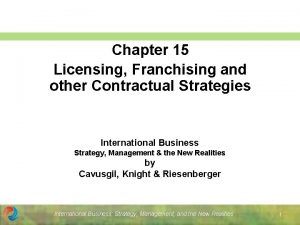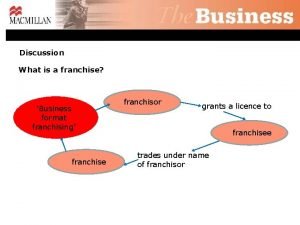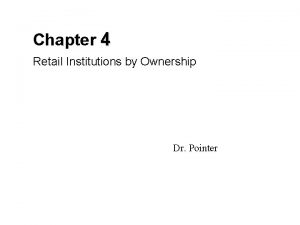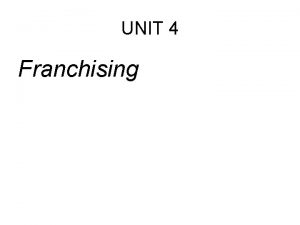Template and guidance Social Franchising Strategy Guide IPPF

















![Goals for social franchising The goal of [Franchise Brand] franchise is to improve access, Goals for social franchising The goal of [Franchise Brand] franchise is to improve access,](https://slidetodoc.com/presentation_image_h2/8d76d48fd34888eb9862427b420a82f8/image-18.jpg)


- Slides: 20

Template and guidance: Social Franchising Strategy Guide IPPF Social Franchising Toolkit Stage 2: Preparing to Franchise

About this document This document will prompt you to answer some key strategic design questions about the shape and purpose of your Social Franchise Network. Once the template is complete, you can delete the guidance slides (like this) to create a Social Franchising Strategy, and use it to clearly communicate your vision to others and inform more detailed plans • Black text – is dummy text that you will need to adapt according to your plans • Red text indicates where information specific to your franchisee network needs to be included • Text in light yellow boxes, (like this) give guidance and ask questions to help you complete the slide deck.

Primary target client / franchise customer) Questions to consider in defining your primary target client • Who do you want to reach with services through social franchising? • How old is your primary target population? • What income bracket? • What geographic area are you trying to reach – rural populations; peri-urban populations? • Which area of the country? Specific provinces or regions? • Which groups are under-served currently and which groups are key to the delivery of your organisational strategy? • Archetype What will your ‘typical’ social-franchise service-user will be in terms of their age, employment stats, relationship status, likes, dislikes. Describing these things in terms of a ‘typical person’ can help bring your target population to life and consider things from their perspective

Primary target client / franchise customer • The primary target population for {MA name}’s social franchising model is {insert key demographic information regarding age, economic status} populations. • Although poor, these clients have some capacity and willingness to pay (otherwise the partnership will not be viable for private providers). • The majority of franchisees will be situated in an [urban, peri-urban, rural {delete as appropriate}] setting within {insert province/ region or delete if national}. Archetypal client profile Sophia is 17, she lives with her mum who is a trader in the nearby market, and 3 her younger brothers. She would like to finish secondary school and become a teacher. She has a boyfriend and they have had sex a few times without using contraception. She doesn’t want to get pregnant, but can’t afford to go to the big ‘youth-friendly IPPF clinic in her local town to get family planning and is scared she’ll be spotted by her mother or others. When she’s not at school she helps her mother with house work and likes to see her friends

Franchise mission: To provide high quality sexual and reproductive health care services to [women, and young people] who are seeking alternatives to the (Insert the problem to which your brand is a solution for clients. E. g. unreliable? Poor quality? Too expensive? ) options that are currently available in the market.

Service Package Questions to consider in defining services you will support your franchisees to offer clients: • Which clinical services are core to your organizational goals? • Which services are not widely available to your target clients in your country / focus area? • Are there any governmental restrictions on which services can be delivered by particular cadres of service provider? For example, in some countries, an IUDs can only be inserted by a Doctor. How does this fit with the profile of your target franchisee? • Which services do you have the capacity to provide training and quality assurance for? Some services require more intense training that others. • Which services are potential franchisees themselves likely to want to add to their service delivery package? Which services will help them increase their client flow, and generate profit?

Service Package • Contraceptive services including counselling; short term methods; at least one long-acting and reversible contraceptive (IUD and/or implants); and at least one emergency contraceptive method. • Safe-abortion care including pre- and post-abortion counselling; and at least one of surgical abortion, medical abortion or treatment of incomplete abortion. • {include any other – see IPES for minimum package}

Franchisee profile In defining the profile of the providers you want to try and franchise, consider the following: • Which type of provider will be best placed to offer services to your target client group? • Which type and level of provider have capacity to provide the services you want to deliver? • Which type of provider might potentially be interested in becoming part of a franchise? Adapt the dummy list on the next two slides to define the characteristics you will look for when selecting franchisees Note! – MAs are advised to initially focus on working with single unit owner-operators (i. e single clinics that are owned and operated by an individual with whom you can form a direct contractual relationship) as this enables a more direct relationship

Franchisee profile In order to meet the objectives of this model, {MA name} seeks to select and recruit clinics that have the following characteristics QUALITY • Is licenced to practice; • Is registered to deliver services by the MOH or other regulatory body; • Is currently weak but has potential to improve; • Is committed to quality improvement; • Agrees to make themselves and/or their staff available for training; • Positive reputation within the community • Agrees to prepare and submit reports to the MA on a monthly basis

Franchisee profile ACCESS • Does not currently offer {insert services in the social franchising package} or does so in a limited way; • Serves a community where there is a gap in supply of these services; • Is not located within XXX km of an MA clinic or another Franchisee; • Opens their clinic at least 5 days per week • Located in the following geographic areas [XXXXXXX] • Located in high traffic / viable areas • Not already affiliated with another franchise brand

Franchisee profile COST EFFECTIVENESS • Is a single unit owner-operated business; • Is not so geographically remote or far from the MA sites that routine monitoring visits would be excessively costly; • Looking to expand their revenue / value / client load • Willing and able to pay franchisee licencing fees {include any cost-sharing or revenue generating approach here}

Franchisee profile EQUITY • Already serves poor and vulnerable populations; • Shares a commitment to reaching the underserved • Is willing to provide free or subsidised services to the poor;

Brand promise Questions to consider in defining your brand promise: • What are the core characteristics of your own brand identity that you’d like reflected and replicated throughout your franchise • What characteristics and values will attract your primary target population?

Brand promise To clients, the Franchise promises: Consistently high-quality clinical care Efficient care (less waiting time) Convenient locations A clean and comfortable atmosphere Privacy, respect, and dignity Signature design that provides assurance of quality (e. g. signature color scheme, decor, and products and equipment) • Good value • Youth friendly and gender sensitive services • • •

Brand promise To clinic owners (franchisees), the Franchise promises: • • • Growing consumer branding and recognition though identification with the Franchise Brand; Reliable source of quality authentic prescription medicines and fair wholesale pricing; Training and clinical skills development; Credentials for service expansion; Marketing and advertising opportunities; Business management systems; Business management training; Assistance with getting access to capital; Headquarters and field support; Consistent and enforced system standards across the entire franchise channel; A network of other clinics sharing the brand; and, Access to product and service expansion and enhancements as they are developed, to qualified and in-compliance operators.

Size of network Questions to consider in developing targets for growth: • How many franchises can you support through your existing infrastructure, and how willing are you to expand existing infrastructure to support more franchisees? • How can you grow at a sustainable pace that will allow you to learn and adapt? • What are your organisational targets around reach and growth? • What are your resourcing constraints?

Size of the network Region A Region B Region C Region D TOTAL No. of existing franchisees Target for 20 XX
![Goals for social franchising The goal of Franchise Brand franchise is to improve access Goals for social franchising The goal of [Franchise Brand] franchise is to improve access,](https://slidetodoc.com/presentation_image_h2/8d76d48fd34888eb9862427b420a82f8/image-18.jpg)
Goals for social franchising The goal of [Franchise Brand] franchise is to improve access, equity, quality, and cost effectiveness of reproductive health care in [Country] thereby improving the health and quality of life of people living in underserved communities. ACCESS: A total of X service delivery points will be included in the network by {date} (scale). The range of services provided in these service delivery points will include {list specific services included in the social franchising package} (scope). EQUITY: The franchising programme will specifically target {specify population group}. QUALITY: Franchisees will improve pre-existing levels of quality and will adhere to national guidelines, IPPF quality standards and {include other}. COST EFFECTIVENESS/SUSTAINABILITY: Services will be provided by franchisees at an equal or lower cost to {MA name}’s other service delivery channels, inclusive of all subsidy or system costs.

MA Franchising Team Questions to consider in building your franchising team: • Who is currently a part of MA staff that has the expertise and interest/desire in social franchising for health? • What existing functions, such as finance and M&E, could support the network? • What new positions, such as Social Franchise Coordinator, will need to be created? What are your resourcing constraints?

MA Franchising Team {examples of positions} Social Franchise Coordinator {revise as appropriate} • Role: Responsible for establishing, implementing and eventually growing the social franchise. • Skills and qualifications: Project management; interpersonal relations; strategic planning; negotiation; strategy development; documentation and resource mobilisation. • Motivations: A desire to expand access to services among the poor and a vision for the long term sustainability of the model. • Quality assurance officer {revise as appropriate}: • Role: Responsible for all quality assurance and quality improvement activities. • Skills and qualifications: Qualified clinician; clinical trainer; quality assurance and quality improvement experience and supply chain management. • Motivations: A commitment to the provision of quality services and a desire to help others.
 Ippf standards
Ippf standards Cuspal angulation
Cuspal angulation Developing guidance skills
Developing guidance skills Licensing franchising and other contractual strategies
Licensing franchising and other contractual strategies Advantages and disadvantages of franchising
Advantages and disadvantages of franchising Franchising co to je
Franchising co to je Franchising introduction
Franchising introduction Partnership advantages and disadvantages
Partnership advantages and disadvantages Franchise format
Franchise format Retail institutions by ownership
Retail institutions by ownership Introduction to franchising
Introduction to franchising Bbc bitesize franchising
Bbc bitesize franchising Objectives of franchising
Objectives of franchising Franchising in algeria
Franchising in algeria Vantaggi e svantaggi del franchising
Vantaggi e svantaggi del franchising The disadvantages of franchising mainly affect
The disadvantages of franchising mainly affect Franchising
Franchising Franchising
Franchising Tony robbins franchise
Tony robbins franchise Franchising prio
Franchising prio Franchising
Franchising






































